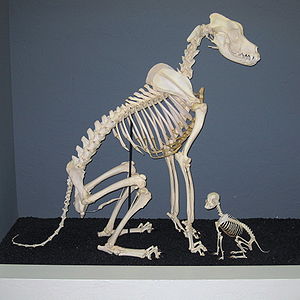Bones - Dog Anatomy
Introduction
This page is concerned with highlighting the bone anatomy of the domestic dog which will include the major aspects of the anatomy and most of the minor elements of anatomy. Very detailed anatomy of individual bones is not covered below due to space restrictions.
The anatomical information included below is commonly split into three separate areas; head, trunk and the forelimbs / hindlimbs. Therefore the following information will use this concept to facilitate easier understanding of the individual areas of anatomy.
Basic Overview
Head
Anatomically the head encompasses all bones cranial to the cervical vertebrae of the neck and is shown in yellow in the diagram above. The head consists of a number of complex bones of varying types and size which will be both described in text and where possible will also be shown photographically.
Trunk
The trunk is in broad terms the body of the animal and is what would remain if the head and limbs were removed. It can be seperated in four parts, the cervical vertebrae (pink above), thorax (orange above), lumbar region (dark blue above) and pelvis (red, label 6 and torquiose above). Anatomically these structures are highly distinguishable and each area has a distinctive shape, size and physiological role.
Limbs
Head
The head is mainly comprised of the skull, mandible, ossicles and hyoid apparatus. Asscessory cartilage is also present within the external ear, larynx and nose.
Skull

The shape and size of the skull varies widely between different breeds of dog. The skull is divided into three components - the neurocranium, the dermatocranium and the viscerocranium.The skull comprises of many individual bones that are fused together to form a strong single structure. These individual bones in adults are fused via ossification of the cartilage between bones that is found in young animals. The skull protects the brain and head against injury and supports the structures of the face. The neurocranium develops from the neural crest and mesoderm and undergoes endochondral ossification. It lies ventral to the brain. The dermatocranium lies dorsal to the brain and develops from the neural crest and mesoderm. It undergoes intramembranous ossification. The viscerocranium is the pharyngeal skeleton. It is derived only from the neural crest and undergoes endochondral and intramembranous ossification. The various facial muscles attach onto the skull in different places depending on their function. The classification of bones within the skull is based on the traditional views of skull drawings such as the historical drawing shown on the right.
Occipital Bone (os occipitale)
The occipital bone forms the nuchal wall and the foramen magnum. The pars basilaris element is the caudal base of the cranium, although rostral to foramen magnum and joined by a cartilagenous suture to basisphenoid bone. It has muscular tubercules on ventral surface where the flexors of the head and neck attach and a caudocranial fossa encloses the pons and medulla oblongata. The squamous part (pars squamosa) is dorsal to lateral parts and occipital condyles. A nuchal crest is present and is easily palpable. The nuchal crest is often used as a landmark for collection of cerebrospinal fluid (CSF). There are also external occipital protuberances present which provide muscle attachment sites for the nuchal ligament. The lateral parts (partes laterales) form the borders of foramen magnum. Occipital condyles are present which articulate with the atlas to form the atlanto-occipital joint. The paracondylar process provide muscle attachment sites for muscles of the head. The hypoglossal canal is also within this structure.
Sphenoid Bone (os sphenoidale)
The sphenoid bone forms the base of the neurocranium and is composed of a body and wings. The bones are separated by cartilage which ossifies with age. The presphenoid (os praespenoidale) is rostral and has a caudal fossa which is a hollow body with sphenoid sinuses located inside. Within the sinuses are the optic chiasma and optic canal. The basisphenoid (os basispenoidalis) is caudal and has a median cranial fossa. The wings oppose the temporal bone, maxilla, orbit and the brain. The wings also form the oval foramen. The pterygoid processes are also present.
Trunk
Forelimb

